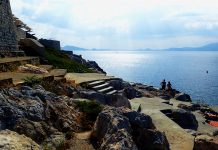Mosque architecture includes elements specific to Islamic worship.
Knowing some terminology and some basic practices of Islam gave added meaning to the beauty of the magnificent Mosques I visited in Istanbul. I hope you too will find them useful, and that they help you make the most of your travels.
You’ll see many words for Mosque on your travels. Camii, Masjid, Jami Masjid, and Mescit are all words for mosque in different cultures. Masjid is the word for Mosque in Arabic. Camii and Mescit are used in Turkey.
Table of Contents
A Vocabulary of Islam and Mosque Architecture
To introduce features of Mosque architecture and understand them in context, it is helpful to know some basics about the practice of Islam.
Salat: Daily Prayer
Salat, or daily prayer, is one of the five pillars of Islam. The faithful pray five times daily- just before dawn, at noon, in the afternoon, at sunset, and at night. The path of the sun determines the times of prayer.
Muslims can respond to the call for prayer wherever they are, and pray anywhere. The exception is the Friday noon prayer, where the faithful should attend prayer at the Mosque, and hear a sermon.
Adhan: The Call to Prayer
The call to prayer is called the Ahdan. As Christians use bells to summon the faithful to worship, the Muslims call out the proclamation that God is Great.
Muezzin: The One who Calls for Prayer
When you visit an Islamic country, you will often wake just before dawn to a beautiful melodic call, delivered like a song. This is the voice of the muezzin. The muezzin has an honored position. He is selected for both his character, and of course for the strength and excellence of his voice.
Muadhan
Another word for Muezzin
Mosque Architecture: Minaret- The Tower Used by the Muezzin to Call for Prayer

At a small mosque, the muezzin may call out from a side door of the Mosque. But larger Mosques generally have one or more minarets. These graceful slim towers are taller than the mosque itself. The muezzin ascends the minaret so that the adhan can be heard far and wide.
The great height of the minaret- much like a spire of a Christian church – is also central to identity. Minarets serve to visually proclaim faith throughout both the countryside and in the urban landscape.
Mosque Architecture: Mihrab – The Ornate Niche that Shows the Direction of Prayer
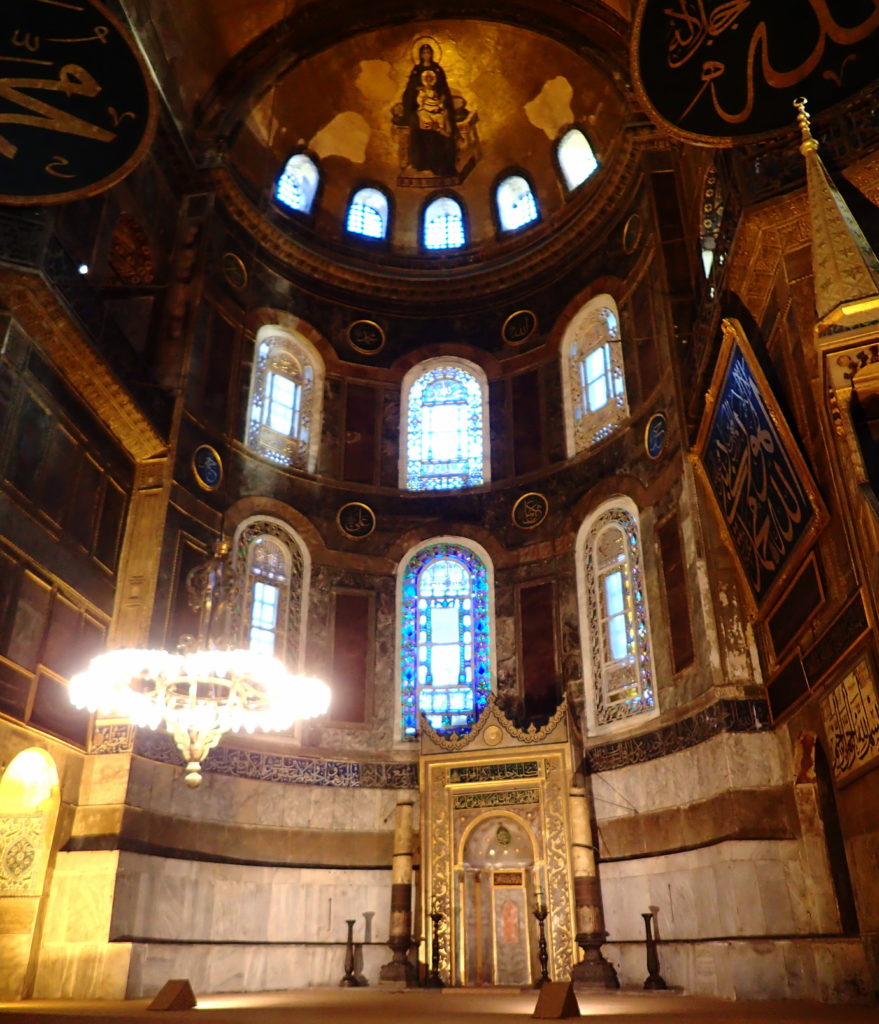
The Mihrab is a central feature of Mosque architecture. It indicates the qiblah, the directions of prayer. Muslims pray in the direction of Mecca.
When you visit a Christian Church that subsequently became a Mosque, you will notice the addition of a mihrab. In the western world, as Mecca is towards the east, and as altars in Christian Churches are in the east, the mihrab is usually close to the former altar.
Mosque Architecture: Minbar- for Delivering Sermons

The most immediately recognizable element of Mosque architecture in the interior in the minbar. A minbar more closely resembles a narrow and graceful staircase, usually with an ornamental canopy at the top, than a platform. The Imam delivers a sermon at the Friday noon prayer from the minbar.
The minbar is placed at the right of the mihrab. The Imam generally does not ascend to the very top of the minbar, as this was the place from which the first caliphs delivered their sermons.
Imam: For Sunni Muslims, the Leader of Worship in a Mosque
The Imam for Sunni Muslims – as practice in Turkey – is also a community leader and a provider of religious guidance. The Imam delivers the sermon, or khutbah, at the Friday noon prayer.
For the Shi’a Muslims, the word Imam comprises a different meaning.
Khutbah: Sermon
Sermons focus on living a life of faith and devotion in accordance with the teachings of the Koran. Here are examples of inspirational topics that a khutbah may touch upon.
Mosque Architecture: Sahn- The Courtyard

Although not an essential feature of Mosque architecture, the courtyard serves an important purpose. Especially in an urban setting, these courtyards provide a tranquil space to cleanse the mind of the noise and cares of the city, and to prepare for prayer.
The sahn also has a practical function. There is very often a fountain for refreshment and for ritual ablutions – wadu – before prayer. It is also a place to remove one’s shoes in order to enter the Mosque.
Sebil- A Public Fountain

All over Istanbul, you will find beautiful ornate kiosks for dispensing water, often in the Ottoman Baroque style. These were a common feature of cities throughout the former Ottoman Empire. Outside of Mosques, at crossroads, and in town squares one would find a sebil, where drinking water would flow freely for all.

Wudu- Ritual Ablutions
To prepare for prayer, the faithful must have a clean mind, heart, and body. Outside of all Mosques, fountains provide a place for these ablutions, which are a specific ritual unto themselves. Wudu not only cleanses the body, but prepares one spiritually for prayer.
Islamic Decorative Vocabulary and Mosque Architecture

Islamic decoration is aniconic, meaning that it does include the depiction of humans or animals. This stems from a prohibition against idolatry, and also a belief that God is the sole creator of living forms. In fact, one of the word used to describe God – “musawwir” – means artist, or maker of forms.
This prohibition of depicting the human form has resulted in a complex and beautiful decorative vocabulary. Islamic artists and craftsmen have risen to the occasion, creating skillful and intricate ornamentation with symbolic meaning.
There are three fundamental types of Islamic decoration:
The Arabesque: A Familiar Decorative Motif in Mosque Architecture

Arabesques cover many surfaces in a Mosque. These sweeping curves and patterns of interlacing forms inspired by flowers, foliage, and tendrils cover many surfaces in a mosque, and are also common motifs found on Iznik tiles. Our excellent guide Ebru of Context Tours explained that botanical motifs represent paradise in Mosque architecture.
Geometric Patterns and Motifs
Islamic scholars of the Golden Age of Islam were great pioneers in the fields of algebra, geometry, trigonometry, and astronomy. Mathematics as an expression of the divine has given rise to beautifully complex patterns and motifs. Circles, interlaced circles, polygons, and stars – some extremely intricate with many points – represent divine infinity. They convey a sense of cosmic unity and harmony.
Logos: Calligraphy as a Decorative Art

Derived from the Greek for “the word,” Logos is a type of Islamic decoration that elevates the art of calligraphy to its height.
Calligraphy conveys not just a message, but is also a powerful decorative element in Mosque architecture.
After Agia Sophia in Istanbul became a Mosque, 8 calligraphic discs of 7.5 meters in diameter – the largest such panels in the Islamic world – were added. On these are written Allah, Muhammed, the four caliphs (religious rulers and successors of Mohammed) – Abu Bukar, Umar, Uthman, and Ali (Son-in-law of Mohammed, married to his daughter Fatima). The other two panels have the names of the grandsons of the Prophet – Hasan and Husayn. Similar discs decorate many other Mosques.
Kufi (Qufi)- The Union of Calligraphy and Geometry

Kufi, developed in the 7th century in Kufa, Iraq, was frequently the script of choice for writing the Koran. This more austere script with a horizontal orientation developed into a form of ornament.
Geometric kufi script appears as an abstract ornament. But in fact it conveys a message in words. This abstract-looking decorative panel from the 16th century Şehzade Mosque in Istanbul reads: “Apart from God there is no other God.”
Muquarnas – The Stalactite Vault
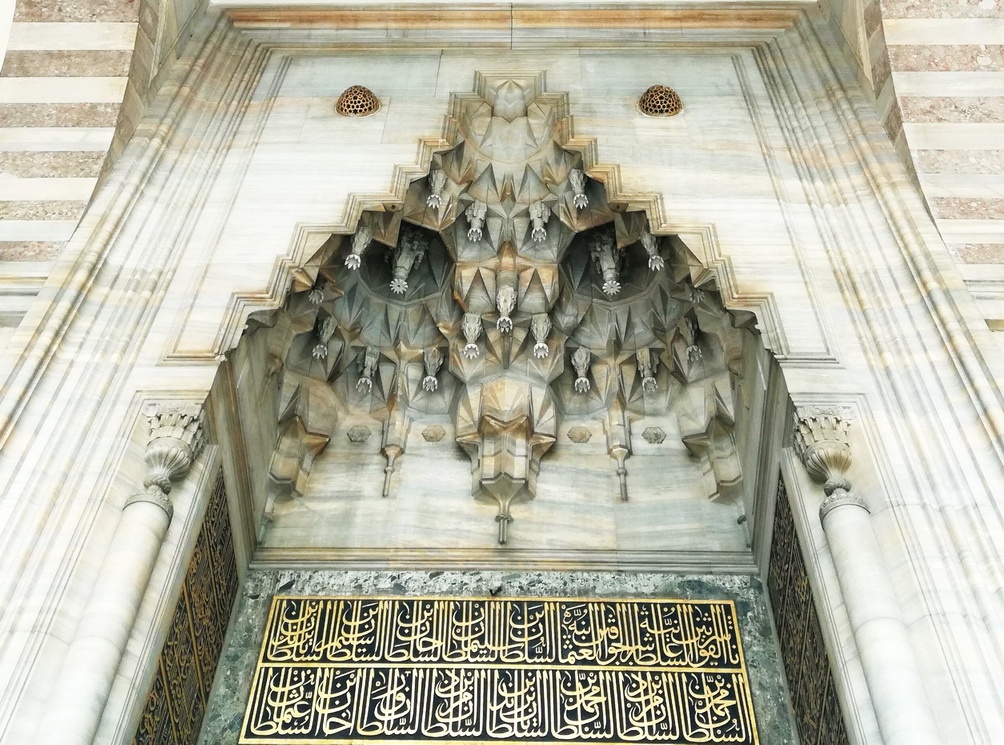
This beautifully intricate geometric motif is one of the most recognizable design elements of Islamic architecture. A muqarnas frequently tops a mihrab or an entrance, or fills the corner spaces where dome tops a square room. It’s a common decorative element, not only in Mosques but also elsewhere.
This intricate, ornamental type of vault consists of interlocking triangles. It is sometimes called “honeycomb” vaulting or “stalactite” vaulting.
The complex geometry of the muqarnas expresses infinity. Drawing the eye upward, it invites us to contemplate heaven and the divine.
Kündekari – an Intricate Puzzle of Wood
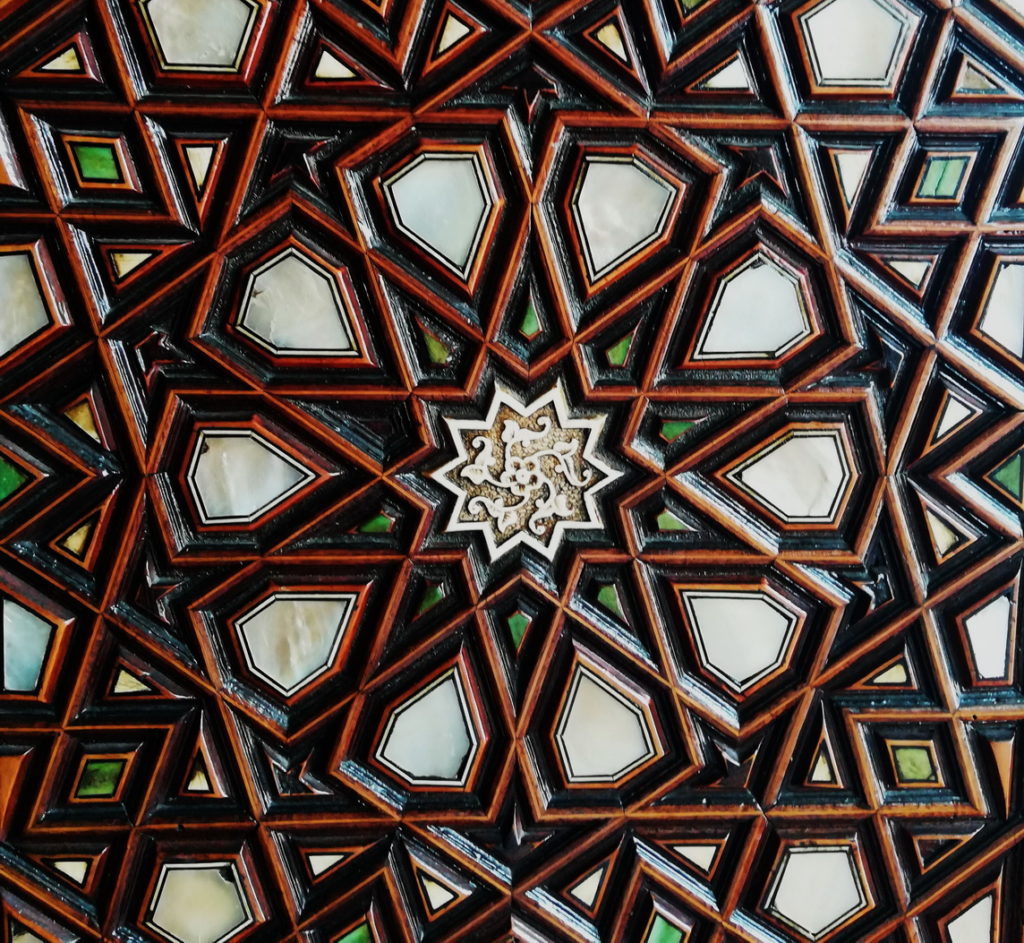
Kündekari is the art of interlocking pieces of wood into complex geometric patterns to form the surfaces of doors, mimbars, shutters, and panels of furniture. No glue or nails are used, which makes the resulting piece of craftsmanship extremely durable against the effects of moisture and heat.
In addition to woods like pear, cedar, ebony, walnut, and rose, kündekari also often includes tortoise shell, mother of pearl, ivory, and metals.
Very few craftsmen today are skilled in kündekari.
You will find beautiful examples of this art in the magnificent Mosques of Istanbul, and in the Topkapi Palace.
Iznik Tiles
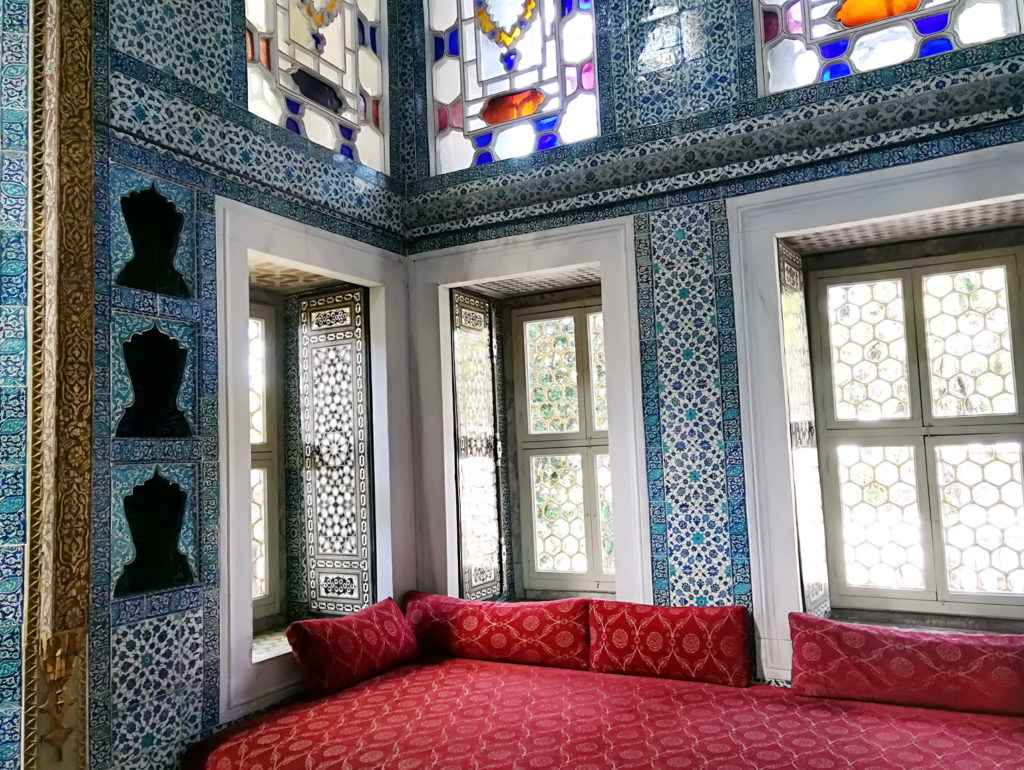
The town of Iznik in the Province of Bursa is famous for its pottery. From the late 15th century through the 17th century, the craftsmen of Iznik produced fine painted pottery and more interestingly still they produced ceramic tiles. The craftsmen of Iznik developed a distinctive loose, flowing style, using arabesques and botanical motifs. To their traditional cobalt blue and pale green, they added red, turquoise, and emerald green. During the reign of Suleiman the Magnificent (1520-1566) in particular, the demand for Iznik tiles and pottery was very high. Mimar Sinan, the great Imperial architect, used Iznik tiles in many of his works.
Excellent examples of Iznik tiles decorate the Rüstem Pasha Mosque. These sumptuous tiles also decorate the Blue Mosque, and parts of the Topkapi palace, such as the Baghdad Kiosk.
Islam, Mosque Architecture, and Islamic Design Motifs
I hope this has been a useful introduction to the meaning and beauty of Mosque architecture for the western traveler. There are many excellent articles available that I was able to consult. I have provide links for those who are interested in reading further.
If any readers have corrections or additional information to share, I will be very grateful.




